One Month in Japan: Explore the Best of Japan
Welcome to Japan! Our detailed guide promises to be your perfect travel companion as you navigate through Japan’s top attractions and secret spots over 30 days.
Whether you’re a first-time visitor eager to hit all the must-see spots or a seasoned traveler looking for deeper experiences, this guide will offer insights into where to go, what to see, where to stay, what to eat, and so on.
Pack your bags and get ready for an unforgettable journey through Japan’s rich culture, stunning landscapes, and welcoming hospitality.
Best Time to Visit Japan
When is the best time to visit Japan? Generally speaking, the ideal times to visit are during the spring (March to May) and autumn (September to November). Each season offers unique experiences, so choose based on what you want to see and do during your visit to Japan.
Spring (March to May):
- Weather: Mild and pleasant.
- Average Temperatures: Tokyo approx. 10°C to 20°C (50°F to 68°F).
- Highlights: Cherry blossoms bloom, transforming parks and cities with beautiful pink flowers. It’s a perfect time for outdoor activities and festivals.
Summer (June to August):
- Weather: Hot and humid, with frequent rains in June (the rainy season).
- Average Temperatures: Tokyo approx. 20°C to 30°C (68°F to 86°F).
- Highlights: Vibrant festivals such as fireworks and traditional dance festivals. Summer is also the best season for climbing Mt. Fuji.
Fall (September to November):
- Weather: Cool and dry, ideal for sightseeing.
- Average Temperatures: Tokyo approx. 15°C to 25°C (59°F to 77°F).
- Highlights: The changing colors of autumn leaves (koyo) offer a stunning display, ideal for temple visits and hiking in the countryside.
Winter (December to February):
- Weather: Cold, especially in northern areas like Hokkaido which can be snowy.
- Average Temperatures: Tokyo approx. 5°C to 12°C (41°F to 54°F); Sapporo in Hokkaido can drop below freezing.
- Highlights: Excellent for winter sports such as skiing and snowboarding in Hokkaido. Winter illuminations and festivals like the Sapporo Snow Festival are major attractions.
Note: When visiting during popular events like Golden Week, it’s wise to book transportation well in advance. For those interested in climbing Mt. Fuji, July is the optimal time, aligning perfectly with the hiking season.
How to Get Around During One Month in Japan
Navigating Japan is surprisingly easy thanks to its efficient and comprehensive transportation network. Whether you prefer the speed of rail, the comfort of private services, or the affordability of buses, there are many options to choose from:
- Japan Rail Pass: This pass is essential for anyone planning to travel extensively across the country. It offers unlimited access to most Japan Railways (JR) trains, including the famous Shinkansen (bullet trains), providing a cost-effective way to see the country.
- Local and Regional Rail Passes: For those focusing their travel on specific regions, local rail passes like the Kansai Area Pass or the Hokkaido Rail Pass can offer unlimited travel within those regions, often including additional discounts on local attractions.
- Buses: Comprehensive bus networks operate within and between cities, offering an economical alternative to trains. Long-distance buses can be a budget-friendly option for travel between major cities, and many tour companies offer bus tours that can take you directly to major tourist attractions.
- Private Limousines and Car Hire: For those looking for a more comfortable and personalized travel experience, private limousines are available for hire. These can be particularly useful for airport transfers or for traveling between cities if you prefer not to navigate public transportation. Car rental is also an option for those who wish to explore more rural areas at their own pace.
- City Transport: In urban areas, subways and local trains are the most convenient ways to get around. Cities like Tokyo, Osaka, and Nagoya have extensive and punctual subway systems. For tourists, prepaid IC cards such as Suica and Pasmo make using these networks simple, as they can be used not just for travel but also for small purchases at convenience stores and vending machines.
- Bicycles: In smaller cities or rural areas, renting a bicycle can be a wonderful way to explore. Many tourist spots offer rental services, and cycling paths are often well marked.
- Ferries: For travel to and from islands like Hokkaido and Okinawa, or for exploring the Seto Inland Sea, ferries can be a scenic and relaxing way to travel.
With all these transportation options, you can tailor your trip based on your preferences, ensuring a smooth and fun adventure through Japan.
Places to Visit With One Month in Japan
Spending a month exploring Japan allows you to immerse yourself in its rich culture and deep history. Every part of Japan has something unique to offer. Let’s take a look at sample itineraries across the main cities in Japan, including where to go, where to stay and what to eat.
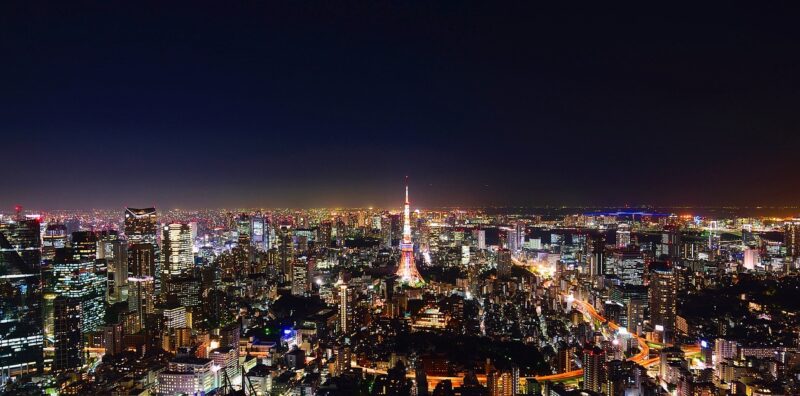
Tokyo
Where to Go:
- Shinjuku Gyoen National Garden: A peaceful retreat amid the city’s hustle, perfect for enjoying cherry blossoms in spring or vivid autumn colors.
- Tokyo Tower: Iconic red tower offering panoramic views of metropolitan Tokyo and beyond, especially stunning at night.
- Meiji Shrine: Dedicated to Emperor Meiji and his consort, this shrine is a serene sanctuary surrounded by a lush forest.
- Asakusa and Senso-ji Temple: An atmospheric area known for Tokyo’s oldest temple, Senso-ji, vibrant festivals, and traditional shopping streets.
- Akihabara Electric Town: The center of Japan’s otaku culture, offering a plethora of electronics, anime merchandise, and maid cafes.
- Tsukiji Outer Market: A bustling market known for fresh seafood and the traditional sushi counters tucked in its busy lanes.
- Harajuku: The heart of Japan’s teenage culture and fashion, famous for its colorful street art, fashion boutiques, and trendy snacks.
- Tokyo National Museum: Located in Ueno Park, it houses an extensive collection of art and antiquities from Japan and Asia.
- Odaiba: A high-tech entertainment hub on a man-made island in Tokyo Bay, known for its futuristic architecture and the giant Gundam statue.
- Shibuya Crossing: Perhaps the world’s busiest pedestrian scramble, offering a quintessential moment of Tokyo’s frenetic energy.
Where to Stay:
- Budget: Sakura Hotel Jimbocho – Affordable, cozy, and conveniently located near public transit, perfect for budget travelers.
- Mid-range: Hotel Niwa Tokyo – Offers a tranquil atmosphere with modern Japanese décor and excellent amenities, located in central Tokyo.
- Luxury: Park Hyatt Tokyo – Known for its elegant rooms and spectacular city views, this hotel offers a luxurious escape in the heart of Shinjuku.
What to Eat:
- Sushi: Experience sushi where it originated, with options ranging from high-end sushi bars to convenient conveyor belt restaurants.
- Ramen: Try Tokyo-style ramen with its slightly thinner noodles and soy-flavored chicken broth.
- Tempura: Savor light and crispy tempura at one of Tokyo’s specialized tempura bars.
- Monjayaki: Tokyo’s version of the savory pancake, best enjoyed at a restaurant in the Tsukishima district.
- Tokyo Banana: A must-try sweet treat, these banana-flavored sponge cakes make perfect souvenirs.

Kanto Region
Where to Go:
- Mt. Fuji: Japan’s tallest peak and an enduring symbol of the country, popular for climbing and photography.
- Hakone Open Air Museum: Combines impressive sculptures with scenic views of Hakone’s natural landscapes.
- Lake Ashinoko: Enjoy a boat ride with views of Mt. Fuji or explore the lakeside shrines.
- Odawara Castle: A beautifully reconstructed castle offering insights into Japan’s samurai past.
- Kamakura: Visit the Great Buddha and numerous ancient temples, only a short trip from Tokyo.
- Nikko: Famous for Toshogu Shrine, lavish resting place of Tokugawa Ieyasu, and beautiful national parks.
- Yokohama Chinatown: The largest Chinatown in Japan, offering an array of Chinese cuisine and colorful temples.
- Enoshima: A small seaside island known for its shrines, caves, and the Enoshima Sea Candle lighthouse.
- Kawagoe: Explore this charming town known as “Little Edo” for its well-preserved Edo-era buildings.
- Tateyama Kurobe Alpine Route: A spectacular route through the Northern Japan Alps, known for its massive snow corridors.
Where to Stay:
- Budget: K’s House Hakone – A friendly hostel with hot springs, offering a mix of traditional and modern comforts.
- Mid-range: Hakone Ginyu – A ryokan that offers stunning mountain views, open-air baths, and exquisite kaiseki meals.
- Luxury: Fujiya Hotel – A historic hotel in Hakone known for its classic architecture and luxurious spa treatments.
What to Eat:
- Kuro-tamago (Black Eggs): Boiled in Owakudani’s volcanic waters, these eggs are said to extend one’s lifespan.
- Yokohama Ramen: Known for its rich, pork-based broth typically flavored with soy.
- Fresh Wasabi: Enjoy fresh wasabi in Shizuoka, a region known for cultivating this pungent plant.
- Houtou Noodles: A comforting, miso-based noodle soup that’s a specialty of the Fuji Five Lakes area.
- Kamakura Shaved Ice: Especially popular in summer, served with sweet syrup and condensed milk.
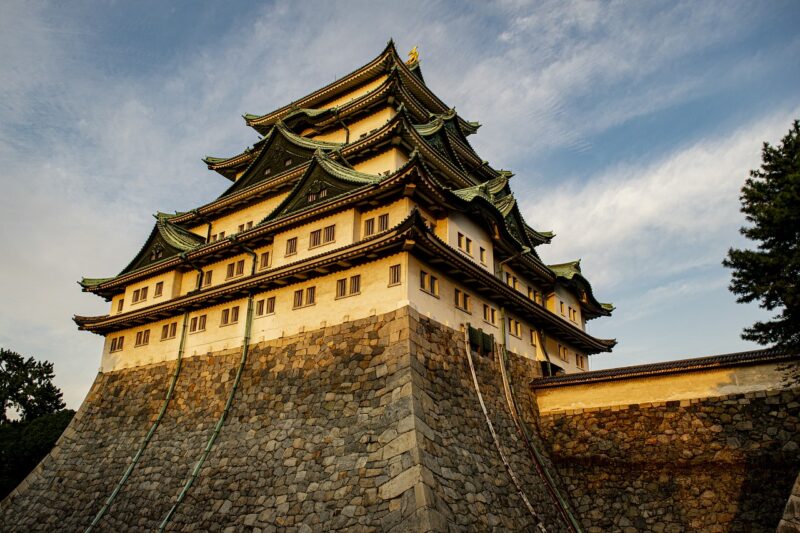
Nagoya
Where to Go:
- Nagoya Castle: Explore this iconic castle famous for its golden shachihoko (tiger-headed carp) statues and lush surrounding gardens.
- Toyota Commemorative Museum of Industry and Technology: Learn about Japan’s automotive history and see how cars are made.
- Atsuta Shrine: One of Japan’s oldest and most important Shinto shrines, housing the sacred sword Kusanagi.
- Osu Kannon Temple and Shopping District: Visit this ancient temple and then explore the nearby streets filled with eclectic shops and eateries.
- SCMaglev and Railway Park: Discover the evolution of Japanese trains, including the famous bullet trains and maglev technology exhibits.
- Port of Nagoya Public Aquarium: See dolphins, whales, and other sea creatures in one of Japan’s largest aquariums.
- Nagoya City Science Museum: Home to the world’s largest planetarium, this museum offers engaging science exhibits.
- Higashiyama Zoo and Botanical Gardens: A place to enjoy diverse animal species and lush botanical collections.
- Noritake Garden: Explore beautifully landscaped gardens and learn about the history of Noritake ceramics.
- Tokugawa Art Museum: Houses treasures belonging to the powerful Tokugawa clan, including samurai armor and ancient scrolls.
Where to Stay:
- Budget: Hostel Wasabi Nagoya Ekimae – A clean and modern hostel offering budget-friendly accommodation close to Nagoya Station.
- Mid-range: Nagoya Tokyu Hotel – Delivers a blend of comfort and elegance with multiple dining options and spacious rooms.
- Luxury: The Westin Nagoya Castle – Right next to Nagoya Castle, this hotel offers luxurious rooms with impressive castle views and top-notch amenities.
What to Eat:
- Hitsumabushi: Grilled eel over rice, which can be enjoyed in three different ways in one meal.
- Miso Katsu: Pork cutlet with a thick, sweet miso sauce—a Nagoya specialty.
- Tebasaki: Spicy glazed chicken wings that are a local favorite, especially at izakayas.
- Kishimen: Flat udon noodles served in a savory broth, typical of Nagoya cuisine.
- Tenmusu: A unique snack of tempura shrimp wrapped in rice and seaweed.

Kyoto
Where to Go:
- Fushimi Inari Shrine: Famous for its thousands of vermilion torii gates, which straddle a network of trails behind the main buildings.
- Kinkaku-ji (Golden Pavilion): A Zen temple with top two floors completely covered in gold leaf, set beside a reflective pond.
- Gion District: Kyoto’s most famous geisha district, offering chances to see geisha and maiko en route to their engagements.
- Arashiyama Bamboo Grove: A breathtaking bamboo forest, perfect for a scenic walk or cycle.
- Kiyomizu-dera Temple: Known for its wooden stage that juts out over the hillside, offering visitors a nice view of the cherry and maple trees below.
- Nijo Castle: An ornamental castle built by the founder of the Edo Shogunate as his Kyoto residence and is surrounded by stunning gardens.
- Philosopher’s Path: A stone path through the northern part of Kyoto’s Higashiyama district, ideal for contemplative walks especially during cherry blossom season.
- Heian Shrine: Recognized for its giant torii gate and extensive gardens, which represent the four seasons.
- Ryoan-ji Temple: Known for its raked gravel Zen garden, one of the most famous in Japan.
- Yasaka Shrine: At the end of Shijo Street, this shrine is especially lively during festivals and is lit up beautifully at night.
Where to Stay:
- Budget: K’s House Kyoto – Friendly and comfortable, this hostel is a favorite among backpackers and budget travelers.
- Mid-range: Hotel Granvia Kyoto – Located in Kyoto Station, this hotel offers excellent transit connections and modern amenities.
- Luxury: Four Seasons Hotel Kyoto – Offers a tranquil retreat in the city, with spacious rooms, a renowned spa, and views of the surrounding temple district.
What to Eat:
- Kaiseki: A traditional multi-course meal that emphasizes seasonal ingredients, typically enjoyed in ryokan or specialty restaurants.
- Yudofu: Boiled tofu served with various dipping sauces, commonly eaten in the colder months.
- Matcha: Kyoto is famous for its quality green tea, which is used in ceremonies and also enjoyed in sweets and beverages.
- Soba: Buckwheat noodles, often served cold with dipping sauce or in a hot broth, enjoyed throughout Kyoto.
- Wagashi: Traditional Japanese sweets, often served with tea, especially beautiful and delicate in Kyoto.
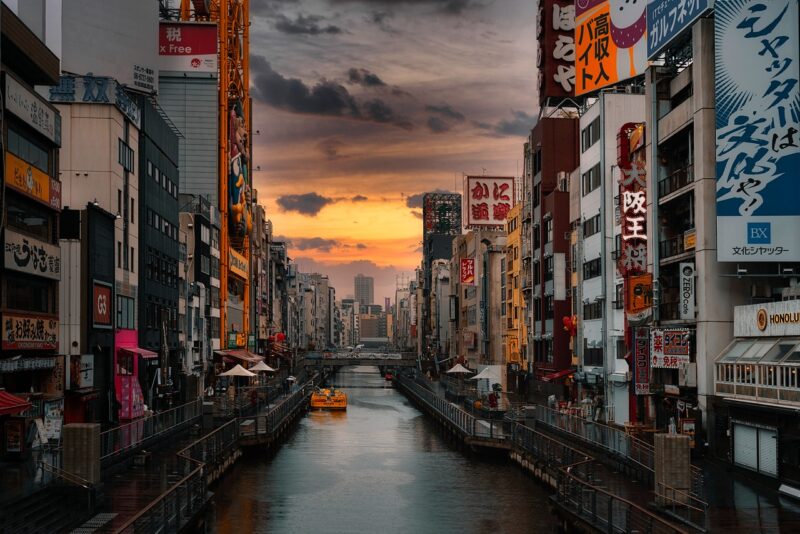
Osaka
Where to Go:
- Osaka Castle: One of Japan’s most famous landmarks, this iconic castle plays a major role in the unification of Japan during the sixteenth century.
- Dotonbori: Renowned for its bright neon lights, bustling atmosphere, and street food, this is the heart of Osaka’s entertainment district.
- Universal Studios Japan: A major theme park that offers a range of thrilling rides and shows, drawing visitors of all ages.
- Umeda Sky Building: Known for its futuristic architecture and a floating garden observatory that offers an unobstructed view of the city.
- Osaka Aquarium Kaiyukan: One of the largest public aquariums in the world, showcasing diverse marine life from around the Pacific Rim.
- Shitenno-ji Temple: The oldest officially administered temple in Japan, established in 593 AD by Prince Shotoku who supported the introduction of Buddhism into Japan.
- Sumiyoshi Taisha: One of Japan’s oldest Shinto shrines, famous for its unique, straight roof design that predates Buddhist influence.
- Namba Parks: An innovative office and shopping complex with a large park that climbs several floors, set in the middle of a busy cityscape.
- Tennoji Zoo: Houses a variety of animals and works for the preservation of natural habitats.
- Osaka Museum of History: Offers exhibits that cover the history of Osaka from ancient times to the present day, with panoramic views of Osaka Castle.
Where to Stay:
- Budget: J-Hoppers Osaka Guesthouse – A friendly, international hostel with a cozy atmosphere, perfect for backpackers.
- Mid-range: Cross Hotel Osaka – Stylish and centrally located, ideal for exploring the bustling districts of Namba and Dotonbori.
- Luxury: The Ritz-Carlton Osaka – Combines modern luxury with traditional Japanese touches and excellent service.
What to Eat:
- Okonomiyaki: Often called the “Osaka soul food,” this savory pancake is made with a variety of ingredients such as cabbage, pork, and seafood.
- Takoyaki: Ball-shaped snacks made of a wheat flour-based batter and cooked with minced or diced octopus, tempura scraps, pickled ginger, and green onion.
- Kushikatsu: Skewered meats and vegetables breaded and deep-fried, served with a dipping sauce.
- Ramen: Particularly the local variety known as “Osaka Black,” known for its dark, rich soy sauce-based broth.
- Yakiniku: Grilled meat cuisine which is very popular in Osaka, often enjoyed with a variety of sauces and sides.
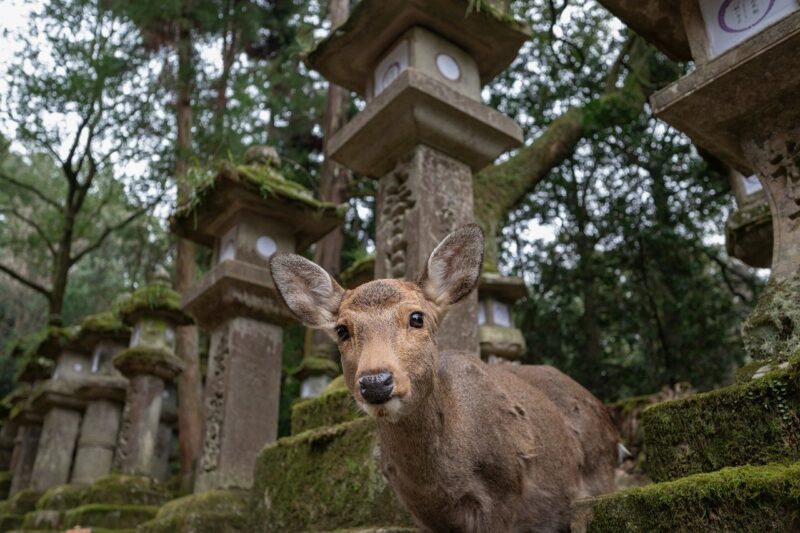
Nara
Where to Go:
- Todai-ji Temple: Home to the world’s largest bronze statue of the Buddha Vairocana, known as Daibutsu, housed in the world’s largest wooden building.
- Nara Park: Famous for its hundreds of freely roaming deer, which are considered messengers of the gods in Shinto.
- Kasuga-taisha Shrine: Known for its many bronze lanterns that line the paths and for its 3000 stone lanterns that light up during the lantern festivals.
- Nara National Museum: Offers a comprehensive collection of Japanese Buddhist art.
- Isuien Garden: A beautiful Japanese-style garden that offers peaceful scenery and teahouse where visitors can enjoy matcha and sweets.
- Horyu-ji Temple: One of the oldest wooden structures in the world and a landmark of Buddhist architecture.
- Heijo Palace: The site of the former imperial palace of the Nara Period, with restored buildings and historical relics.
- Wakakusa Yamayaki: An annual festival where the grass on the hillside of Nara’s Mount Wakakusayama is set on fire.
- Yoshikien Garden: A pleasant garden that is particularly popular during autumn when the leaves change color.
- Kofuku-ji Temple: This temple features a five-story pagoda, the second tallest in Japan, and an extensive collection of Buddhist statuary.
Where to Stay:
- Budget: Guesthouse Nara Backpackers – Located in a renovated traditional Japanese house that offers a genuine feel of Nara’s historic atmosphere.
- Mid-range: Nara Hotel – This historic hotel blends modern comfort with traditional Nara culture, situated close to Nara Park and major temples.
- Luxury: Noborioji Hotel – Known for its elegant blend of modern luxury and classic Nara culture, offering exquisite dining and service.
What to Eat:
- Kakinoha-zushi: Sushi wrapped in persimmon leaves, a local specialty that has a unique aroma and flavor.
- Chagayu: A rice porridge that is cooked with tea instead of water, typically seasoned with salt.
- Persimmon Leaf Sushi: Unique to Nara, this sushi is preserved and flavored with the natural antibacterial properties of persimmon leaves.
- Narazuke: Vegetables pickled in sake lees, offering a distinctive tangy taste.
- Deer Crackers (Shika-senbei): Sold throughout Nara Park, these are specially made crackers that you can feed to the deer.
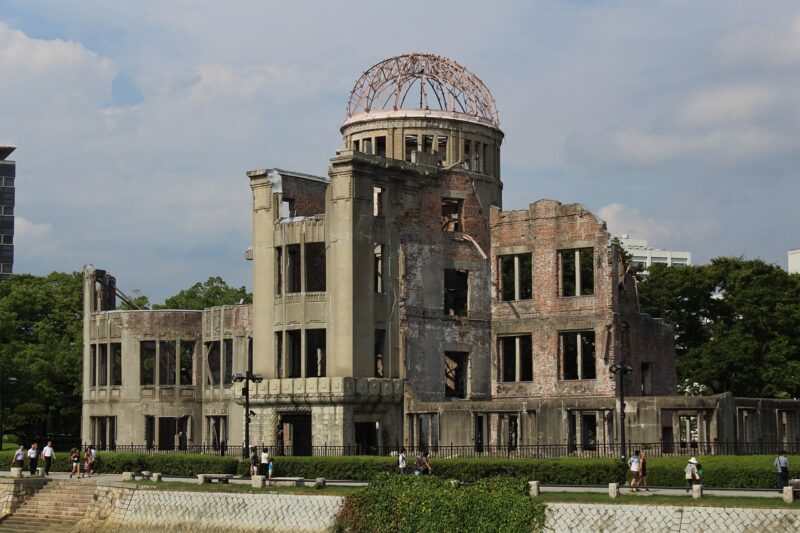
Hiroshima
Where to Go:
- Hiroshima Peace Memorial Park: Central to Hiroshima’s identity, this park is dedicated to the legacy of Hiroshima as the first city in the world to suffer a nuclear attack.
- Atomic Bomb Dome: One of the few buildings left standing near the center of the atomic blast, now a UNESCO World Heritage Site and a poignant reminder of peace.
- Hiroshima Castle: Also known as Carp Castle, this is a good example of a castle built on a plain in the center of a city as opposed to on a hill or mountain.
- Shukkeien Garden: A historic Japanese garden that dates back to 1620, offering a scenic retreat with miniature landscapes in its design.
- Miyajima Island: Famous for its “floating” torii gate of Itsukushima Shrine, the island is a short ferry ride from the city and offers hiking, traditional crafts, and wildlife.
- Hiroshima Museum of Art: Hosts both European and Japanese art, including works by Monet and Picasso alongside modern Japanese artists.
- Peace Memorial Museum: Documents the atomic bomb and its aftermath, aiming to advocate for peace and nuclear disarmament.
- Hiroshima Orizuru Tower: Offering a panoramic view of the city and interactive activities related to peace messages.
- Mazda Museum: A fascinating tour for car enthusiasts, showcasing Mazda’s history and its latest automotive technologies.
- Hiroshima Gogoku Shrine: A shrine associated with warriors, rebuilt after the war and now a venue for several Japanese festivals.
Where to Stay:
- Budget: Ikawa Ryokan – A traditional Japanese inn offering simple accommodations and warm hospitality, close to Peace Park.
- Mid-range: Hotel Sunroute Hiroshima – Overlooking the Peace Memorial Park, providing comfortable rooms and easy access to the city’s main attractions.
- Luxury: Sheraton Grand Hiroshima Hotel – A deluxe hotel with refined amenities and a touch of elegance, conveniently located near Hiroshima Station.
What to Eat:
- Okonomiyaki: A savory pancake that is Hiroshima’s soul food, layered with ingredients rather than mixed, including noodles and a generous amount of cabbage.
- Hiroshima-style Tsukemen: Noodles served with a separate dipping sauce, enriched with flavors of fish and pork broth.
- Momiji Manju: A maple leaf-shaped cake filled with sweet red bean paste, a favorite souvenir from Miyajima.
- Oysters: Hiroshima is famous for its oysters, which can be enjoyed raw, grilled, steamed, or fried.
- Hiroshima Carp Bento: A popular local dish especially on game days, featuring rice topped with seasoned carp.
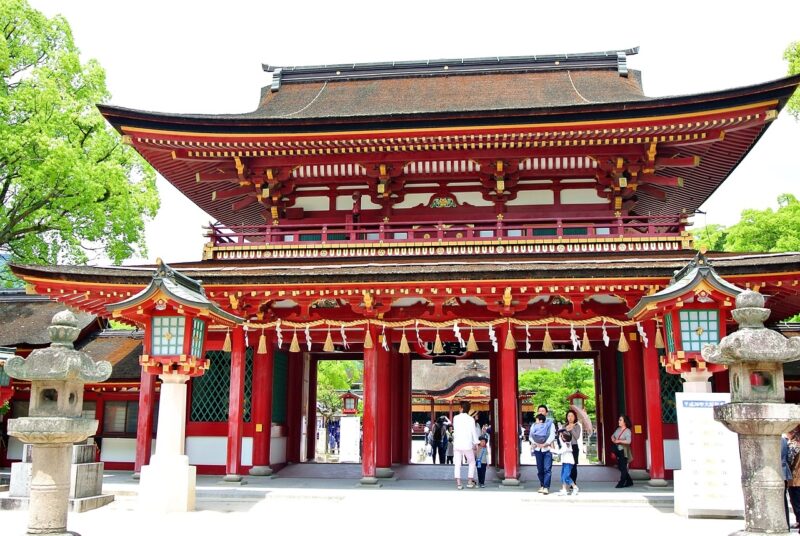
Fukuoka / Kyushu
Where to Go:
- Dazaifu Tenmangu Shrine: Dedicated to the scholar Sugawara no Michizane, this shrine is surrounded by thousands of plum trees and is a site for students seeking blessings for academic success.
- Ohori Park: A serene park centered around a large pond where visitors can rent boats or enjoy a leisurely walk around the water.
- Fukuoka Castle Ruins: Explore the remains of Fukuoka’s castle within Maizuru Park, offering cherry blossom views in spring.
- Canal City Hakata: A large shopping and entertainment complex with a canal running through it, offering shops, cafes, theaters, and water shows.
- Nanzoin Temple: Known for housing one of the largest reclining Buddha statues in the world.
- Kushida Shrine: A historical Shinto shrine that is the focal point of Fukuoka’s famous Hakata Gion Yamakasa festival.
- Hakata Machiya Folk Museum: Offers a glimpse into the traditional way of life in Fukuoka, with restored townhouses and craft demonstrations.
- Fukuoka Asian Art Museum: Focuses on modern and contemporary art from Asia, promoting cultural exchanges between Asian countries.
- Marine World Uminonakamichi: An aquarium located on a scenic peninsula, showcasing marine life from around Kyushu and beyond.
- Yanagibashi Rengo Market: Known as “Fukuoka’s kitchen,” this market is the perfect place to sample local seafood and produce.
Where to Stay:
- Budget: Guest House Hokorobi – Offers simple, clean accommodations with a friendly atmosphere, ideal for backpackers.
- Mid-range: Hakata Tokyu REI Hotel – Conveniently located near Hakata Station, this hotel offers modern comforts and easy access to public transport.
- Luxury: Hotel Okura Fukuoka – A taste of luxury in the heart of Hakata, offering spacious rooms, fine dining options, and first-class service.
What to Eat:
- Hakata Ramen: Rich, creamy pork bone broth with thin noodles, often served with toppings like pork belly, green onions, and sesame seeds.
- Mentaiko: Spicy cod roe, typically served with rice, pasta, or as a topping on other dishes.
- Chicken Nanban: Fried chicken marinated in a sweet and sour sauce, usually served with a side of tartar sauce.
- Tonkotsu: Another type of pork broth that is thicker and more intense than the broth used in Hakata ramen, often used in various noodle dishes.
- Yuzu Kosho: A spicy citrus paste that combines yuzu peel, chili peppers, and salt, adding a zesty flavor to many Kyushu dishes.
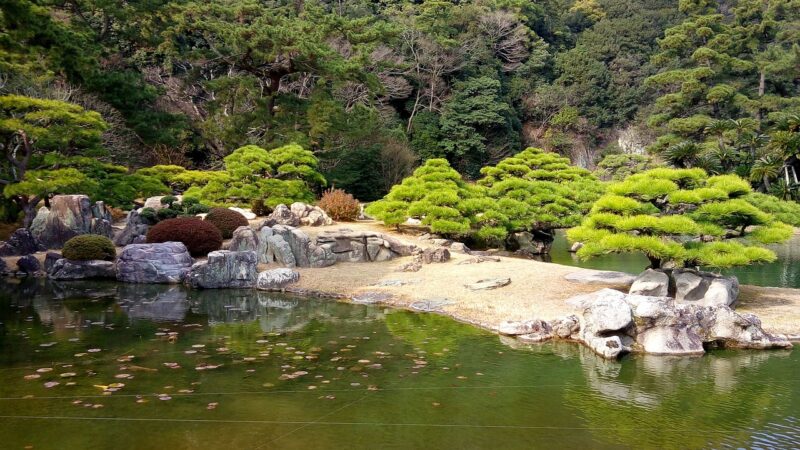
Shikoku
Where to Go:
- Ritsurin Garden: One of the most famous historical gardens in Japan, known for its scenic beauty and the perfect setting for a peaceful stroll.
- Kotohira-gu Shrine: Also known as Konpira-san, this Shinto shrine is nestled halfway up Mount Zozu and requires a climb of 785 steps to reach, offering rewarding views and rich history.
- Iya Valley: A remote, mountainous valley known for its dramatic scenery, traditional vine bridges, and ancient thatched-roof houses.
- Naruto Whirlpools: Witness the dramatic tidal whirlpools under the Naruto Bridge, best seen during spring and autumn tides.
- Shimanami Kaido: A scenic biking route that connects Shikoku to the main island of Honshu, featuring breathtaking island and ocean views.
- Kochi Castle: One of only twelve original castles in Japan that hasn’t been rebuilt, offering insights into the feudal past and panoramic views of the surrounding area.
- Dogō Onsen: One of the oldest hot springs in Japan, famous for its historic bathhouse which inspired the animated film “Spirited Away.”
- Matsuyama Castle: Positioned on Mount Katsuyama, this castle provides a panoramic view of Matsuyama and the Seto Inland Sea.
- Oboke and Koboke Gorges: Spectacular river gorges known for their rugged, dramatic cliffs and white-water rafting opportunities.
- Chikurin-ji Temple: Located in Kochi, this temple is known for its beautiful garden and as one of the stops along the Shikoku Pilgrimage.
Where to Stay:
- Budget: Sen Guesthouse – Located in Matsuyama, this guesthouse offers affordable, clean accommodation with a friendly, communal atmosphere.
- Mid-range: Clement Uwajima Hotel – A comfortable hotel in Uwajima that provides good access to local attractions and friendly service.
- Luxury: Setouchi Retreat Aonagi – Offering minimalist luxury and stunning architecture, this hotel provides a serene escape with spectacular views of the Seto Inland Sea.
What to Eat:
- Sanuki Udon: Famous in Kagawa, these chewy, thick wheat noodles are typically served hot in a simple broth or cold with a dipping sauce.
- Katsuo no Tataki: Seared bonito, lightly grilled on the outside and sliced thin, served with garlic and other seasonings.
- Sudachi Soba: Buckwheat noodles served with sudachi, a citrus fruit native to Tokushima, adding a refreshing zest.
- Imabari Yakibuta Tamago Meshi: A popular local dish in Ehime, featuring rice topped with grilled pork and eggs.
- Olive Beef: Premium beef from cattle raised on olives, known for its tenderness and rich flavor, specific to Kagawa.
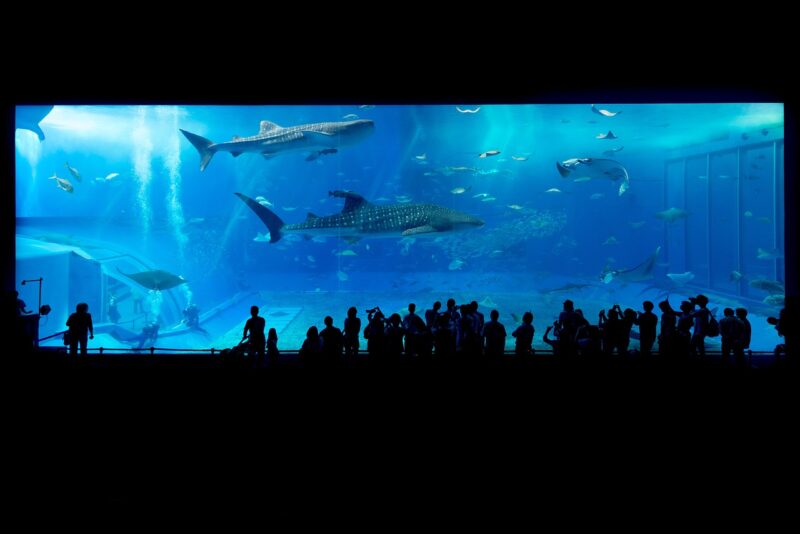
Okinawa
Where to Go:
- Shurijo Castle: Symbolizing the Ryukyu Kingdom’s history, recently reconstructed after a fire, it offers insights into the former kingdom’s culture.
- Okinawa Churaumi Aquarium: One of the largest aquariums in the world, famous for its massive Kuroshio Tank containing large whale sharks and manta rays.
- Naha’s Kokusai Dori: The main shopping street in Naha, lined with shops, restaurants, and bars, bustling with energy and local flavors.
- Peace Memorial Park: Located at the southern tip of the island, this park commemorates the Battle of Okinawa and promotes peace.
- Manzamo Cape: Known for its elephant trunk-shaped cliffs and stunning ocean views, it’s an ideal spot for sunset views.
Taketomi Island: A small island near Ishigaki, known for its traditional Ryukyu village, sandy streets, and well-preserved coral houses. - Ishigaki Island: Known for its beautiful beaches, clear waters, and excellent snorkeling and diving opportunities.
- Miyako Island: Famous for its white sandy beaches and clear blue waters, ideal for water sports.
- Himeyuri Peace Museum: Dedicated to the female students and teachers who perished during the Battle of Okinawa.
- Ryukyu Mura: A theme park showcasing traditional Okinawan village and culture, with performances and craft workshops.
Where to Stay:
- Budget: Guest House Kerama – A budget-friendly guesthouse in Naha, providing simple, clean accommodations and a friendly atmosphere.
- Mid-range: Hotel Royal Orion – Situated in the heart of Naha, close to shopping and dining options, offering comfort and convenience.
- Luxury: The Busena Terrace – Nestled on a private beach, this luxury resort offers exquisite rooms, excellent dining, and extensive wellness facilities.
What to Eat:
- Okinawa Soba: Unlike mainland soba, Okinawa soba is made from wheat flour and served in a broth made from pork or fish.
- Goya Champuru: A stir-fry dish made with bitter melon, tofu, eggs, and pork or Spam, embodying the fusion of Okinawan and American influences.
- Rafute: Slow-cooked pork belly simmered in awamori (Okinawan sake), soy sauce, and sugar, known for its melt-in-your-mouth texture.
- Taco Rice: A popular Okinawan dish that combines ground beef, lettuce, cheese, and salsa on a bed of rice – a testament to American influence.
- Mozuku: A type of seaweed unique to Okinawa, often served in vinegar as a side dish or appetizer, noted for its health benefits.
Summary
Spending a month in Japan gives you the perfect amount of time to really dive into the country’s varied landscapes, rich culture, and amazing food. With some smart planning, you can see everything from the bright lights of its bustling cities to the quiet beauty of its rural areas.
Planning for a shorter trip? Check out this article for an expert pick for a 10-day itinerary in Japan.
Let this guide help you put together the ideal itinerary, setting you up for a journey that’s sure to be packed with unforgettable memories.
Looking for a travel agency to help with your planning?
Contact Firefly Japan today and let’s start crafting your dream trip to Japan!